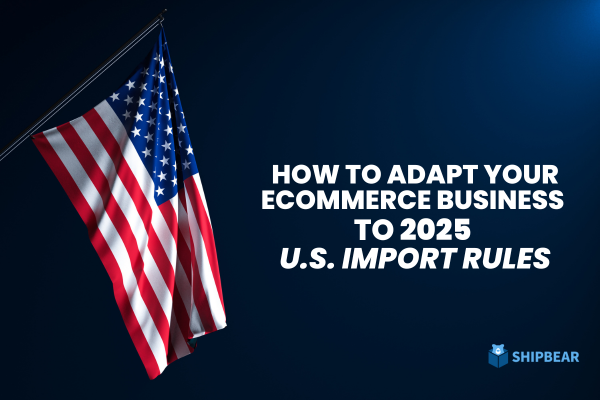Introduction: The Changing Landscape of U.S. Imports
The eCommerce industry is facing its biggest shake-up in years. Starting in 2025, U.S. import rules are eliminating key cost-saving exemptions while imposing stricter customs rules—forcing online sellers to rethink their supply chains.
For years, the $800 de minimis rule allowed small-value shipments from China to enter the U.S. duty-free. But now, this exemption is being revoked for most consumer goods, including electronics, apparel, and home products. At the same time, tariffs on Chinese imports have surged to as high as 145%, and customs inspections have become far more rigorous.
These changes mean that traditional direct-from-China dropshipping is no longer viable for many sellers. Shipping delays, unpredictable fees, and compliance risks are making it harder than ever to maintain profitability.
So what’s the solution?
The most successful sellers are shifting to a hybrid fulfillment model—combining bulk shipping to U.S. warehouses with strategic dropshipping for flexibility. This approach reduces costs, speeds up delivery, and minimizes risk.
In this guide, we’ll break down the following:
✅ The 2025 trade policy changes and their impact
✅ Why pure dropshipping is becoming unsustainable
✅ How a hybrid fulfillment strategy can protect your business
✅ ShipBear’s solutions for seamless bulk shipping + dropshipping
Section 1: The 2025 U.S. Import Policy Changes – What’s Different?
1.1 The End of Duty-Free Small Shipments
Previously, the de minimis exemption allowed packages valued under $800 to enter the U.S. without customs duties. This was a game-changer for eCommerce sellers, especially those using AliExpress, CJ Dropshipping, or other China-based suppliers.
But starting May 2025, this exemption no longer applies to most goods from China, including:
- Electronics (smartphones, accessories, gadgets)
- Apparel & footwear (clothing, shoes, bags)
- Home goods (furniture, decor, kitchenware)
- Toys & recreational items
What does this mean? Every shipment now requires full customs declaration and duty payment, significantly increasing costs for sellers who rely on direct-from-China fulfillment.
1.2 Higher Tariffs – Up to 145% in Some Cases
The U.S. has introduced new tariffs on Chinese imports, with rates climbing steeply in 2025:
- March 2025: A new 10% baseline tariff took effect.
- April 2025: Combined tariffs reached 145% for some categories.
- May 2025: Postal shipments now face either a 120% duty or a $100 minimum charge per item (whichever is higher).
- June 2025: The flat-rate postal tariff will increase to $150 per item.
Impact: Sellers who used to ship low-cost items directly to customers now face skyrocketing landed costs, making many products unprofitable.
1.3 Stricter Customs Enforcement = More Delays
U.S. Customs has also tightened regulations, requiring:
🔹 Accurate manufacturer pricing (no more undervaluing shipments)
🔹 Correct HTS codes (wrong classifications lead to fines)
🔹 Full supplier documentation (more paperwork = slower clearance)
Result: Increased inspection rates, longer shipping times, and higher compliance risks for dropshippers.
Section 2: Why Pure Dropshipping Is No Longer Sustainable
For years, dropshipping from China was a low-risk way to start an eCommerce business. But in 2025, this model is becoming too expensive and unreliable. Here’s why:
🚫 Problem #1: Exploding Costs
- Every small shipment now faces customs duties + tariffs (sometimes doubling or tripling product costs).
- Slow shipping + high return rates hurt customer satisfaction.
🚫 Problem #2: Unpredictable Delays
- Increased customs inspections mean packages get held up for weeks.
- Customers won’t wait 15-20 days for orders anymore.
🚫 Problem #3: Compliance Risks
- Wrong paperwork = seized shipments + fines.
- Amazon & Walmart penalize sellers with late deliveries.
Bottom line: If you’re still relying on pure dropshipping, your profit margins are shrinking fast.
Section 3: The Smart Solution – Hybrid Fulfillment (Bulk + Dropshipping
The most successful sellers in 2025 are using a hybrid model:
✅ Step 1: Bulk Shipping for Best-Sellers
- Import your top products in bulk via sea freight (cheaper than air).
- Store inventory in U.S. warehouses (ShipBear has fulfillment centers nationwide).
- Fulfill orders domestically in 2-3 days (vs. 15+ days from China).
Benefits:
✔ Lower costs (bulk shipping = lower per-unit fees)
✔ Avoid repeated tariffs (pay duties once, not per order)
✔ Faster delivery = happier customers
✅ Step 2: Strategic Dropshipping for Flexibility
While bulk shipping is ideal for steady-selling items, keeping some products on dropshipping helps with:
🔹 New product testing (avoid overstocking untested items)
🔹 Low-volume SKUs (don’t tie up cash in slow movers)
🔹 Seasonal/trending items (flexibility for short-term demand)
This hybrid approach gives you:
✔ Better cash flow (only bulk order what sells)
✔ Lower inventory risk (avoid dead stock)
✔ Faster adaptation (test new products easily)
Section 4: How ShipBear Makes Hybrid Fulfillment Easy
At ShipBear, we specialize in helping sellers transition from pure dropshipping to a hybrid model. Here’s how we help:
🚢 Bulk Shipping Services
- Sea & air freight from China to U.S. warehouses
- Customs clearance handled for you (no paperwork stress)
- Distributed fulfillment centers for fast U.S. delivery
📦 On-Demand Dropshipping
- Same-day sourcing from vetted suppliers
- Quality checks before shipping
- Direct-to-customer or to your U.S. warehouse
📊 Smart Inventory Management
- AI demand forecasting (predict stock needs)
- Automated replenishment alerts (never run out)
- Real-time tracking across sales channels
🛒 Seamless Platform Integrations
- Plug-and-play connections with Shopify, Amazon, Walmart
- API access for custom solutions
- Unified dashboard for all fulfillment operations
Section 5: Real-World Success Stories
Case Study #1: Fashion Brand Cuts Costs by 42%
Problem: Facing 120% tariffs on direct shipments
Solution:
- Bulk shipped 70% of inventory to ShipBear’s LA warehouse
- Kept 30% on dropshipping for new designs
Result:
✅ 42% lower fulfillment costs
✅ 3-day U.S. delivery (vs. 18 days before)
✅ 27% higher conversion rate
Case Study #2: Home Goods Seller Eliminates Stockouts
Problem: Constant shortages of best-sellers
Solution:
- Bulk stocked evergreen products
- Dropshipped seasonal items
Result:
✅ No more stockouts on core products
✅ 35% lower storage costs
✅ Kept ability to test new products risk-free
Conclusion: Future-Proof Your Business in 2025
The old way of dropshipping no longer works. With higher tariffs, stricter customs, and longer delays, sellers must adapt—or risk losing profits.
The hybrid fulfillment model (bulk shipping + strategic dropshipping) is the best way to:
✔ Slash costs (avoid repeated tariffs)
✔ Speed up delivery (2-3 days vs. weeks)
✔ Stay flexible (test new products easily)
ShipBear makes this transition seamless. Our bulk shipping, U.S. warehousing, and dropshipping services give you the perfect balance of cost efficiency + flexibility.
🚀 Ready to future-proof your eCommerce business?
📞 Contact ShipBear today for a free consultation!



